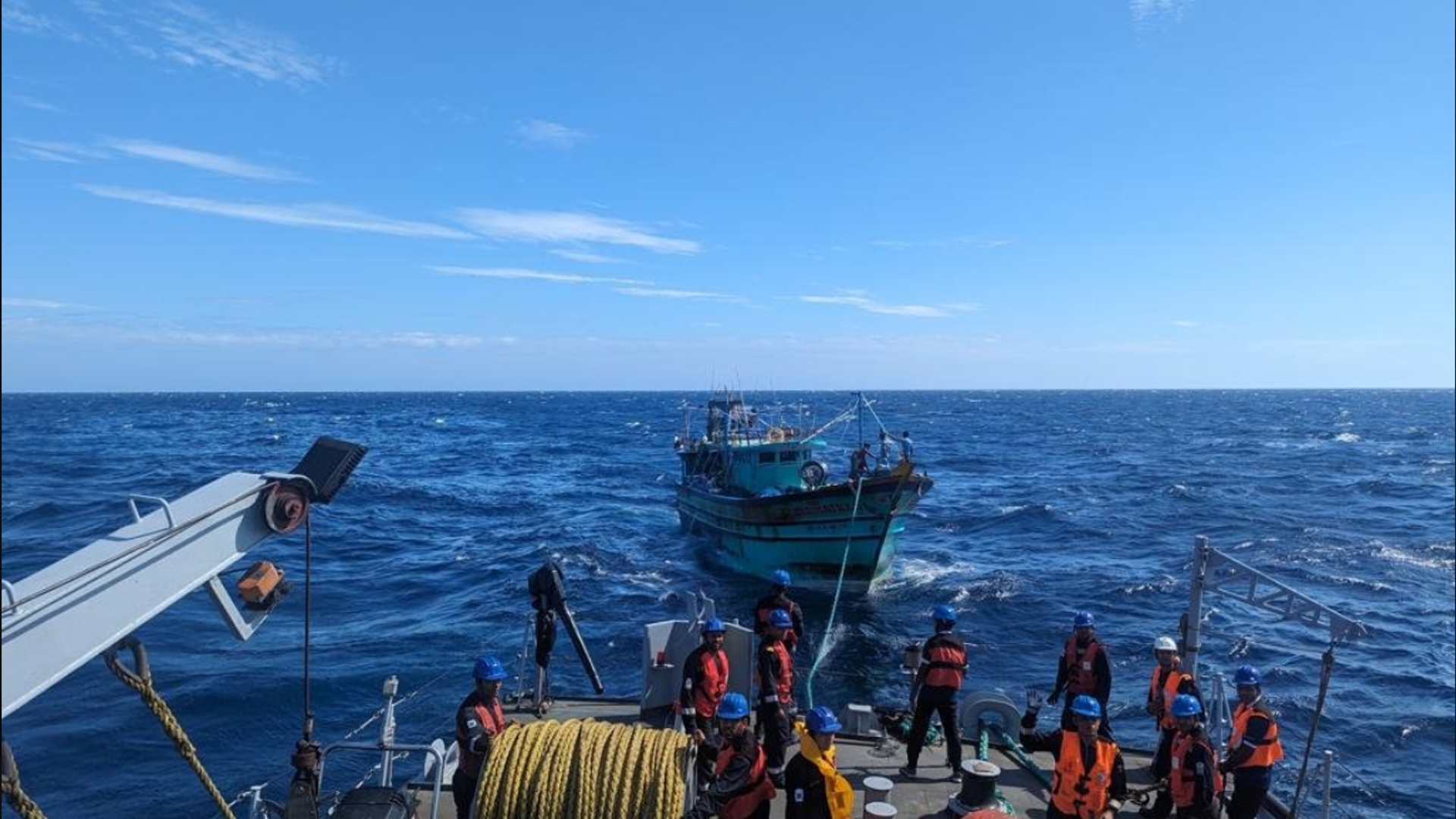https://sputniknews.in/20230929/non-traditional-security-threats-increase-in-the-indian-ocean-4478118.html
Non-Traditional Security Threats Increase in the Indian Ocean
Non-Traditional Security Threats Increase in the Indian Ocean
Sputnik India
A new report has found that the number of maritime incidents of "non-traditional security threats" in the Indian Ocean has gone up by 19% - from 162 in July to 193 last month.
2023-09-29T19:26+0530
2023-09-29T19:26+0530
2024-01-19T17:33+0530
india
indian ocean
south asia
indian navy
the united nations (un)
human traficking
food insecurity
food crisis
humanitarian crisis
indo-pacific
https://cdn1.img.sputniknews.in/img/07e7/07/1d/3270137_0:109:1164:764_1920x0_80_0_0_48b5a58733406055d1ba8b573904d183.png
A new report has found that the number of maritime incidents of "non-traditional security threats" in the Indian Ocean has gone up by 19% - from 162 in July to 193 last month.According to the Information Fusion Centre's recent report, the Indian Ocean region's spurt in maritime security challenges includes upticks in the flow of illicit drugs over the established shipping lanes since the Covid-19 outbreak.The current economic instability in Sri Lanka and Pakistan has also contributed to what the report defines as non-traditional maritime security threats.Meanwhile, piracy and armed robbery has decreased by 54% from 22 reported incidents in July to 10 last month.The majority of reported incidents involved drug smuggling, which was followed by smuggling of wildlife, domestic goods, fuel, and natural resources.What Are Non-Traditional Maritime Security Threats?A wide range of issues fall under the umbrella of non-traditional security (NTS) threats, including:Non-traditional threats present a challenge to national and international stability in the current environment of global security. Given its vast, diverse, and sometimes unregulated nature, the seas are especially vulnerable to these threats.The Indian Ocean region (IOR) has 36 littorals and 14 adjacent hinterland states, populated by over three billion people. Forty percent of global trade and half of the world’s container traffic traverse this ocean, with it providing the shortest and most economical sea routes linking the Atlantic and the Pacific Oceans.The acceptance of non-military or "non-traditional" security threats is the outcome of the shift in how "security" has been defined since the Cold War. These threats are transnational, prompting many academics, policymakers and government officials to believe that regional and multilateral approaches are essential to establishing coping mechanisms.Impact of Security Threats on South AsiaDrug trafficking poses a menace to not only South Asia but to the entire world. Geographically, South Asia has been situated between the "Golden Triangle" and "Golden Crescent," the two primary global hubs for the production of drugs, posing a serious threat to the region. South Asia has proven to be a significant transit route for drugs produced in the region.Migration is a problem for South Asia's security as well. Large-scale international and internal migration has an effect on the countries of origin and destination. The two main problems associated with cross-border mobility are irregular migration and human trafficking.Research claims that people trafficking has developed into a $32 billion global industry, making it the second-largest and fastest-growing criminal activity. The United Nations estimates that 2.4 million individuals worldwide are the victims of this horrible crime, with 80% of those victims falling victim to the sex trade.Piracy has been a persistent maritime hazard. In fact, reports of trade and travel in the Indian Ocean from the 12th century indicate that piracy has been prevalent. The International Maritime Bureau's Piracy Reporting Centre (IMB PRC) indicates that there were fewer armed robberies and acts of piracy worldwide in 2022. However, the number of incidents in the Singapore Strait has increased year to year since 2021. Bulk carriers were the most often targeted ship type in the majority of incidents, which normally take place at night in the eastbound channel of the Strait.Illegal, unreported and unregulated (IUU) fishing also poses a grave danger to marine security, and the current situation is bleak. The Indian Ocean is host to some of the more important fisheries in the world and accounts for over 14 percent of all global fishing. India Combats Maritime Security ThreatsIndia participates in numerous cooperative mechanisms including the "Shared Awareness and De-confliction (SHADE)" program that has been set up to enhance information exchange in order to reach a high level of collaboration with other maritime forces.Apart from constant patrolling around the region, India has also taken a regional cooperation stance in terms of handling the non-traditional security threat.India continues to prioritize preventing any polarization of the IOR despite its efforts to position itself at the center of regional dynamics. India has restricted itself to bilateral interactions with significant extra-regional powers.Although this serves in part to underscore India’s benign intentions, the country is showing signs of reviewing its military engagement policy.
india
indian ocean
south asia
indo-pacific
persian gulf (arabian gulf)
Sputnik India
feedback.hindi@sputniknews.com
+74956456601
MIA „Rossiya Segodnya“
2023
Swapna Nair
https://cdn1.img.sputniknews.in/img/07e7/09/12/4320104_0:0:681:681_100x100_80_0_0_ca8a7d4d582609272840ffdd1cde7278.jpg
Swapna Nair
https://cdn1.img.sputniknews.in/img/07e7/09/12/4320104_0:0:681:681_100x100_80_0_0_ca8a7d4d582609272840ffdd1cde7278.jpg
News
en_IN
Sputnik India
feedback.hindi@sputniknews.com
+74956456601
MIA „Rossiya Segodnya“
Sputnik India
feedback.hindi@sputniknews.com
+74956456601
MIA „Rossiya Segodnya“
Swapna Nair
https://cdn1.img.sputniknews.in/img/07e7/09/12/4320104_0:0:681:681_100x100_80_0_0_ca8a7d4d582609272840ffdd1cde7278.jpg
information fusion centre— indian ocean region, maritime incidents, indian ocean region (ior), sri lanka, pakistan, non-traditional maritime security threat, irregular human migration, contraband smuggling, illegal unreported and unregulated (iuu) fishing, piracy and armed robbery, traffic separation scheme (tss), singapore strait, gulf of guinea, manila anchorage, philippines,mauritius, yemen, atlantic, the pacific oceans, mass migration, resource depletion, infectious illnesses, natural disasters, transnational crime, climate change, and food shortages, piracy and terrorism, illicit trafficking of drugs and weapons, human trafficking, climate change, natural disasters, illegal migration and food shortages, multilateral approaches , south asia, golden triangle, golden crescent.
information fusion centre— indian ocean region, maritime incidents, indian ocean region (ior), sri lanka, pakistan, non-traditional maritime security threat, irregular human migration, contraband smuggling, illegal unreported and unregulated (iuu) fishing, piracy and armed robbery, traffic separation scheme (tss), singapore strait, gulf of guinea, manila anchorage, philippines,mauritius, yemen, atlantic, the pacific oceans, mass migration, resource depletion, infectious illnesses, natural disasters, transnational crime, climate change, and food shortages, piracy and terrorism, illicit trafficking of drugs and weapons, human trafficking, climate change, natural disasters, illegal migration and food shortages, multilateral approaches , south asia, golden triangle, golden crescent.
Non-Traditional Security Threats Increase in the Indian Ocean
19:26 29.09.2023 (Updated: 17:33 19.01.2024) Such threats include piracy, illegal fishing and mass migration.
A new report has found that the number of maritime incidents of "non-traditional security threats" in the Indian Ocean has gone up by 19% - from 162 in July to 193 last month.
According to the Information Fusion Centre's recent report, the Indian Ocean region's spurt in maritime security challenges includes upticks in the flow of illicit drugs over the established shipping lanes since the Covid-19 outbreak.
The current economic instability in Sri Lanka and Pakistan has also contributed to what the report defines as non-traditional maritime security threats.
Irregular human migration incidents rose 29% to 22 last month, while unreported and unregulated fishing went up 28% to 73 reported incidents. Likewise, there were 88 contraband smuggling reports. July's tallies were 17, 57, and 88, respectively.
Meanwhile, piracy and armed robbery has decreased by 54% from 22 reported incidents in July to 10 last month.
The majority of reported incidents involved drug smuggling, which was followed by smuggling of wildlife, domestic goods, fuel, and natural resources.
What Are Non-Traditional Maritime Security Threats?
A wide range of issues fall under the umbrella of non-traditional security (NTS) threats, including:
Non-traditional threats present a challenge to national and international stability in the current environment of global security.
Given its vast, diverse, and sometimes unregulated nature, the seas are especially vulnerable to these threats.
The Indian Ocean region (IOR) has 36 littorals and 14 adjacent hinterland states, populated by over three billion people. Forty percent of global trade and half of the world’s container traffic traverse this ocean, with it providing the shortest and most economical sea routes linking the Atlantic and the Pacific Oceans.
The acceptance of non-military or "non-traditional" security threats is the outcome of the shift in how "security" has been defined since the Cold War.
These threats are transnational, prompting many academics, policymakers and government officials to believe that regional and multilateral approaches are essential to establishing coping mechanisms.
Impact of Security Threats on South Asia
Drug trafficking poses a menace to not only South Asia but to the entire world. Geographically, South Asia has been situated between the "Golden Triangle" and "Golden Crescent," the two primary global hubs for the production of drugs, posing a serious threat to the region.
South Asia has proven to be a significant transit route for drugs produced in the region.
Migration is a problem for South Asia's security as well. Large-scale international and internal migration has an effect on the countries of origin and destination. The two main problems associated with cross-border mobility are irregular migration and human trafficking.
Research claims that people trafficking has developed into a $32 billion global industry, making it the second-largest and fastest-growing criminal activity. The United Nations estimates that 2.4 million individuals worldwide are the victims of this horrible crime, with 80% of those victims falling victim to the sex trade.
Piracy has been a persistent maritime hazard. In fact, reports of trade and travel in the Indian Ocean from the 12th century indicate that piracy has been prevalent.
The International Maritime Bureau's Piracy Reporting Centre (IMB PRC) indicates that there were fewer armed robberies and acts of piracy worldwide in 2022.
However, the number of incidents in the Singapore Strait has increased year to year since 2021. Bulk carriers were the most often targeted ship type in the majority of incidents, which normally take place at night in the eastbound channel of the Strait.
Illegal, unreported and unregulated (IUU) fishing also poses a grave danger to marine security, and the current situation is bleak.
The Indian Ocean is host to some of the more important fisheries in the world and accounts for over 14 percent of all global fishing.
India Combats Maritime Security Threats
India participates in numerous cooperative mechanisms including the "Shared Awareness and De-confliction (SHADE)" program that has been set up to enhance information exchange in order to reach a high level of collaboration with other maritime forces.
Similarly, India passed the Anti-Maritime Piracy Bill (2019) in December 2022 to reassure shipowners and operators that countering maritime piracy in the region continues to be a high priority.
Apart from constant patrolling around the region, India has also taken a regional cooperation stance in terms of handling the non-traditional security threat.
India continues to prioritize preventing any polarization of the IOR despite its efforts to position itself at the center of regional dynamics. India has restricted itself to bilateral interactions with significant extra-regional powers.
Although this serves in part to underscore India’s benign intentions, the country is showing signs of reviewing its military engagement policy.


